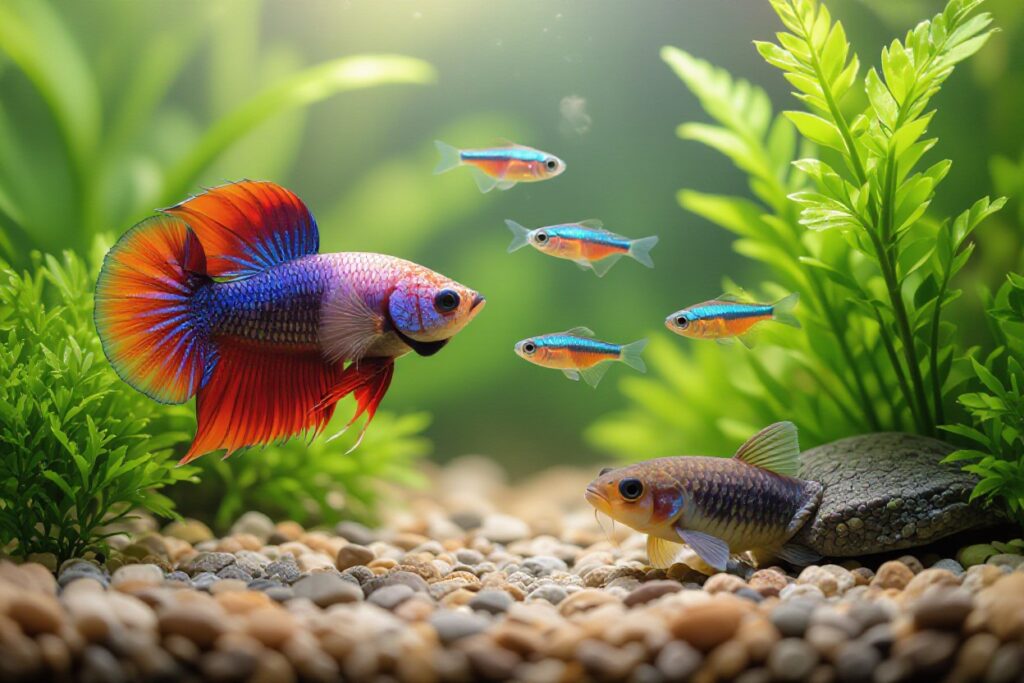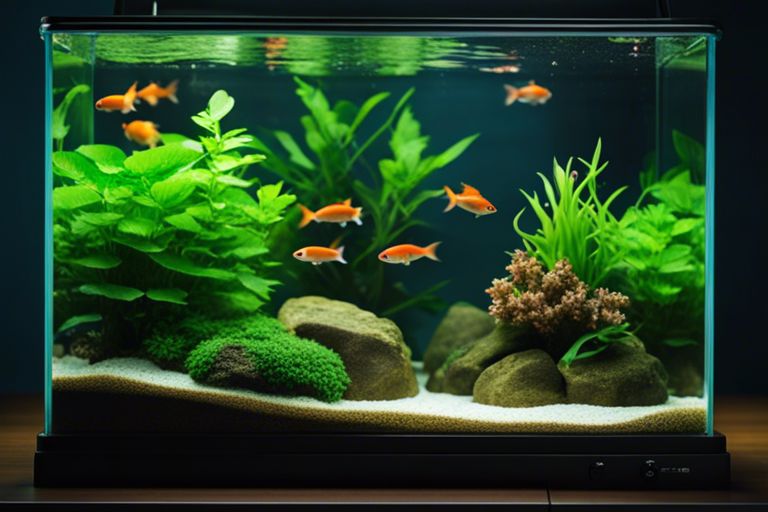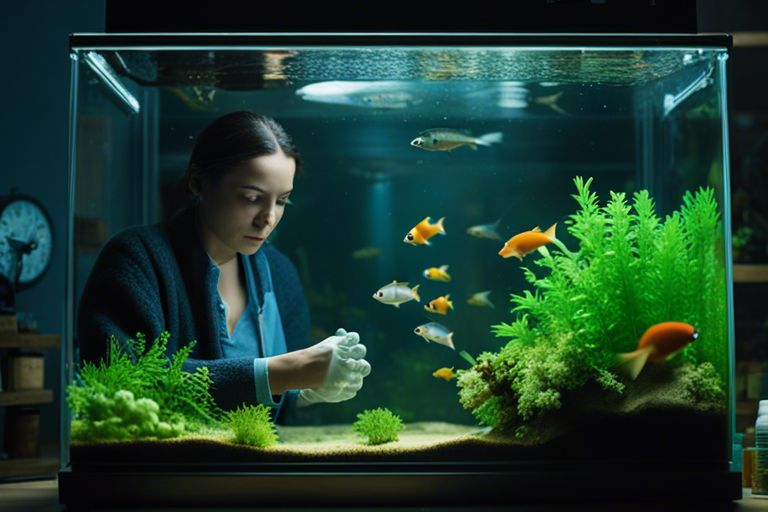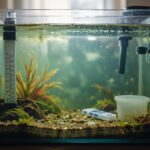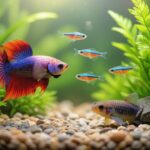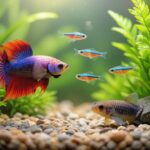With dirty fish tank problems, you must recognize signs like cloudy water, algae overgrowth and foul odors, test for ammonia spikes and nitrite/nitrate issues, then apply quick fixes, long-term solutions and prevention strategies to restore clear, healthy water and protect your fish.

Common Causes of Cloudy Water
Types of Cloudiness
When diagnosing dirty fish tank problems, you’ll see distinct cloud types: a milky white bacterial bloom after a big feeding, gray/opaque particulate cloudiness from disturbed substrate, green haze from algae overgrowth, brown tea from tannins, and a chemical film from phosphate or silica. For example, bacterial blooms often peak within 24–72 hours after a 50% water change or filter disruption, while algae builds over days with excess light and nitrates.
- Bacterial bloom – milky, appears fast after nutrient spikes.
- Particulate waste – gray, caused by stirred substrate or overfeeding.
- Algae overgrowth – green tint, linked to excess light and nitrates.
- Tannins – brown water from driftwood or peat.
- Thou should test for ammonia spikes and nitrite/nitrate issues immediately when cloudiness appears.
| Cause | Indicator / Quick action |
| Bacterial bloom | Milky white water; do a 30–50% water change, increase aeration, check ammonia & nitrite. |
| Particulate suspension | Gray/opaque; vacuum substrate, reduce feeding by 50%, improve mechanical filtration (pre-filter 4× tank flow). |
| Algae | Green tint; cut light to 6–8 hrs, remove manual growth, test nitrates (keep <20 ppm), add algae-eating species. |
| Tannins / dissolved organics | Brown tea; use activated carbon or perform 25% water changes until clear; source-check driftwood. |
| Chemical haze | Oily sheen or persistent haze; test phosphates/silicates, use chemical media, replace old filter floss. |
Solutions for Cloudy Water
You can clear most cloudiness with targeted steps: perform an initial 30–50% water change, vacuum the substrate, rinse or replace mechanical media, cut feeding by half, and test water for ammonia >0.25 ppm or nitrite. For bacterial blooms, increase aeration and avoid overcleaning beneficial media; for algae, reduce light to 6–8 hours/day and control nitrates under 20 ppm.
Apply a structured approach: first, run tests (ammonia, nitrite, nitrate, pH) and document values; then take a staged response—if ammonia >0.25 ppm act fast with a 50% change and ammonia detoxifier, if nitrate >40 ppm schedule weekly 30% changes and add live plants to uptake nitrates. In mechanical fixes, aim for a filter turnover rated at least 4× the tank volume per hour and use a fine floss or pre-filter sponge to trap particulates; avoid throwing away all biological media—retain at least 50% of colonized media when cleaning. For persistent bacterial blooms, consider a short run with a UV sterilizer (rated for your tank size) or incremental water changes over 3–5 days rather than a single massive change to prevent further destabilizing your cycle. Finally, prevent recurrence by reducing feedings to what fish eat within 2 minutes, scheduling substrate vacuums every 1–2 weeks, and keeping a light schedule and nitrate targets to minimize repeat dirty fish tank problems.
Understanding Algae Blooms
When algae take hold in your aquarium, they change water clarity, oxygen dynamics and aesthetic appeal; you’ll see green water, slimy mats or black beard patches depending on conditions. Fast growth often points to excess light, high nitrate/phosphate levels or disrupted microbiology, and can trigger dirty fish tank problems like stress, reduced feeding and oxygen dips that harm sensitive species. Act quickly to limit spread and protect your livestock.
Types of Algae and Their Effects
You need to identify which algae you’re facing because treatment varies: single-celled green water clouds, filamentous hair algae that cling to decor, brown diatoms common in new tanks, black beard/red algae that resist trimming, and cyanobacteria which smells foul and forms mats.
| Green Water (single-celled) | Cloudy green tint, high chlorophyll; reduce light to 8–10 hours, boost filtration or use UV sterilizer; aim for nitrate <20 ppm. |
| Filamentous / Hair Algae | Strings on plants and decor; remove manually, cut nutrient sources, increase CO2 in planted tanks; grazers like Amano shrimp help control growth. |
| Diatoms (brown algae) | Brown dust on surfaces in new tanks; often due to silicates and phosphorus—perform 25–30% water changes and clean substrate to clear within weeks. |
| Black Beard / Red Algae | Stubborn tufts on leaves and hardscape; low-light tolerant—treat with manual removal, Excel/CO2 dosing in planted tanks, and consistent nutrient balance. |
| Cyanobacteria (blue-green) | Slimy mats with a foul odor, oxygen-sapping at night; improve circulation, blackout 48–72 hours, vacuum detritus and test for high ammonia/phosphate. |
- dirty fish tank problems often trace back to excess nutrients and lighting.
- algae overgrowth can be an early indicator of failing filtration or infrequent water changes.
- ammonia spikes and high nitrite stress fish and favor opportunistic blooms.
- pH problems shift biological balance and sometimes favor specific algae types.
- Knowing how each factor—light, nutrients, flow—interacts lets you target fixes precisely.
Effective Control Methods
You should combine immediate mechanical removal with long-term chemical and biological controls: perform 25–30% weekly water changes, limit light to 8–10 hours/day, keep nitrate <20 ppm, use phosphate-absorbing media, and add grazers or a UV sterilizer for persistent single-celled blooms; these steps reduce dirty fish tank problems and restore balance.
Start with diagnostics: test ammonia (target 0 ppm), nitrite (0 ppm) and nitrate (<20 ppm), and measure phosphate (aim <0.1 mg/L). Install a timer for lights, run stronger filtration or a properly sized UV unit (≈1 W per 10–20 gallons for green water), and dose phosphate media for 2–4 weeks. Introduce biological controls—Siamese algae eaters, Amano shrimp, Nerite snails—after stabilizing water parameters. Avoid broad-spectrum algaecides unless as a last resort because they can damage nitrifying bacteria; instead, target causes and follow up with maintenance plans (weekly tests, substrate vacuuming, and locked light schedules).
Water Chemistry and Its Importance
Within dirty fish tank problems, water chemistry dictates whether fish thrive or suffer; you need tight control of ammonia, nitrite, nitrate, pH, hardness and temperature. Aim for 0 ppm ammonia, nitrite below 0.1 ppm and nitrate under 20–40 ppm. Sudden pH swings greater than 0.5 units can stress or kill fish, while a stable biofilter keeps ammonia and nitrite suppressed. Monitor trends, since a one-time reading can hide an emerging bacterial bloom or filtration failure.
Key Parameters to Monitor
Focus on ammonia, nitrite, nitrate, pH, KH/GH, temperature and dissolved oxygen. Use a liquid test kit for accuracy and test at least twice weekly when troubleshooting, otherwise weekly on a stable tank. If ammonia reads 0.5 ppm or nitrite hits 1.0 ppm, act immediately. Track KH to predict pH drift and GH for species-specific needs; for example, tetras prefer GH 3–8°d, African cichlids often need GH 10–20°d. Log numbers to spot trends.
Adjusting Water Chemistry
Start with targeted partial water changes: 30% for moderate issues, 50% for acute ammonia spikes, and vacuum the substrate to remove detritus. Dose a dechlorinator and increase aeration to protect gill function. Adjust pH slowly—no more than 0.2 units per day—using buffers or natural methods like peat or crushed coral depending on direction. Re-test 4–6 hours after intervention, then daily until stable.
Lower ammonia fast by reducing feeding, performing a 50% water change if readings exceed 0.25–0.5 ppm, and using ammonia binders as a temporary measure while seeding nitrifying bacteria (e.g., add commercial starter or transfer filter media). For high nitrates, employ weekly 20–30% changes and consider live plants or denitrifying media. When shifting pH for sensitive species—say from 8.2 to 7.5—spread changes over several days and use crushed coral to raise pH or peat/RO mixing to lower it, avoiding sudden swings that cause shock.
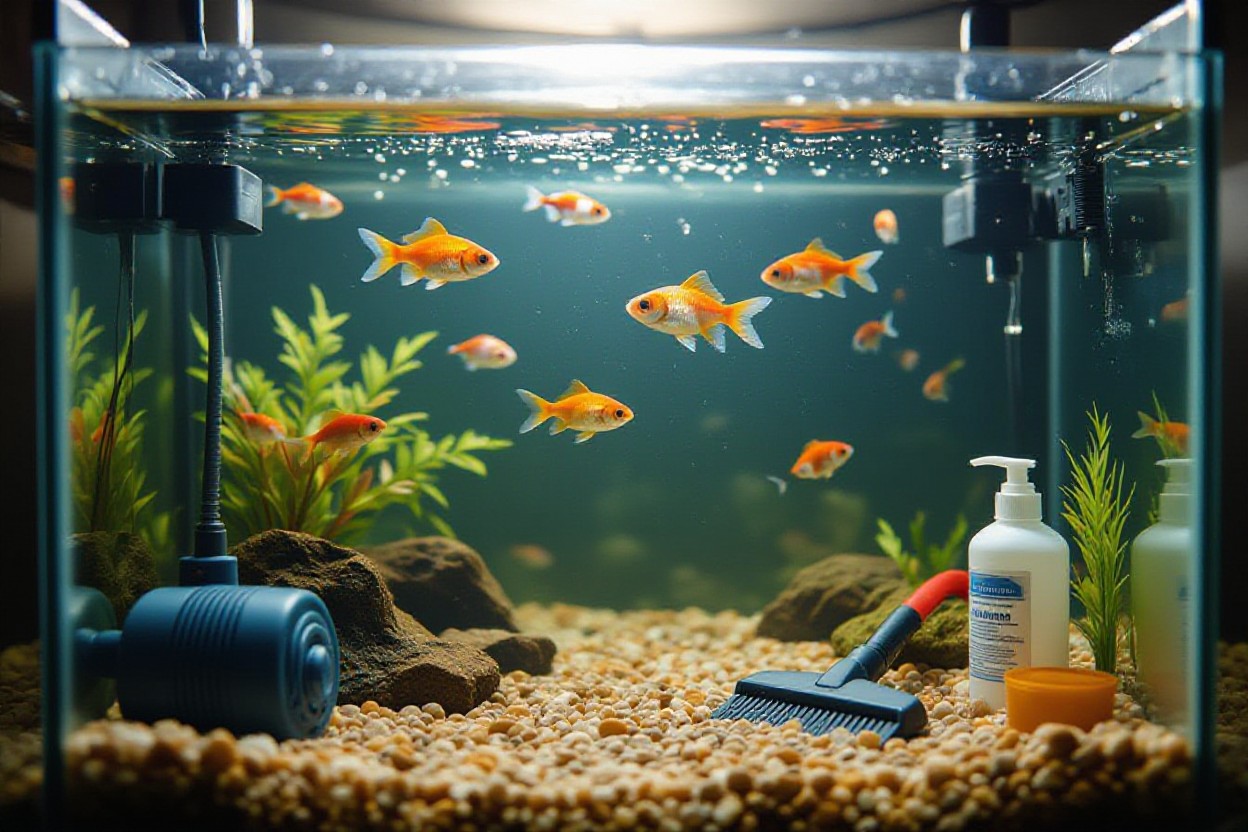
Identifying and Addressing Odor Issues
Signs of foul smells usually point to organic buildup, anaerobic pockets, or bacterial blooms within your aquarium. If you notice a rotten-egg sulfur odor or persistent mustiness, test your water: any measurable ammonia (>0 ppm) or nitrite indicates biological stress, while nitrates above 40–50 ppm often accompany chronic smells. You should inspect filter intake, substrate, and hidden decaying matter first to isolate the source quickly and safely.
Common Sources of Odor
Overfeeding and uneaten food generate soft, sour smells as it decomposes, and dead fish or plant detritus produce sharp, rotten odors. Clogged filters and compacted substrate create anaerobic zones that release hydrogen sulfide. You’ll also see odor when biological filtration is overwhelmed—for example, an ammonia spike of 0.5–2 ppm after a missed water change often correlates with strong foul scents.
Solutions for Odor Prevention
Perform regular 25–30% weekly water changes, siphon the gravel every change, and remove uneaten food or carcasses promptly. Maintain your biological filter by rinsing media in tank water every 2–4 weeks, and use activated carbon or chemical media to adsorb dissolved organics (replace monthly). Cut feeding to once daily or use feeding rings to reduce waste and keep flow rates high to limit dead zones.
When odors persist, take immediate corrective steps: if tests show ammonia >0 ppm, do an urgent 25–50% water change and dose an ammonia neutralizer while you address the biofilter. For anaerobic substrate pockets, vacuum deeply across multiple small water changes rather than one huge disturbance to avoid stressing fish. Mechanical filtration upgrades—adding a sponge pre-filter or increasing flow by 20–30%—and routine activated carbon replacement typically eliminate lingering smells within 48–72 hours. Track readings (ammonia, nitrite, nitrate) after each intervention to confirm improvement.
Routine Maintenance to Prevent Problems
Regular Cleaning Practices
You should perform a 25–30% water change weekly for heavily stocked or smaller tanks and 10–20% for low-stock setups; during that time siphon the substrate to remove uneaten food and detritus, scrape glass and décor for algae, and vacuum 60–80% of visible waste. Test ammonia, nitrite, and nitrate each week; if any reading is elevated, increase water-change frequency and cut feeding by 25–50% to stop dirty fish tank problems before they escalate.
Equipment Checks and Replacements
Inspect filters, heaters, air pumps, and lights every 1–2 weeks: confirm filter flow matches the tank size (aim for 4–10× turnover/hour), verify the heater holds temperature within ±1°C, and replace activated carbon every 4–6 weeks; avoid swapping all biological media at once to prevent ammonia spikes and bacterial loss. Keep spare parts on hand so you can act fast when equipment fails.
Practical routine: label a maintenance calendar—weekly: test water, top off, and clean glass; biweekly: rinse sponges in tank water and check tubing for blockages; monthly: replace carbon, inspect impeller and intake, and measure light output (replace bulbs at 6–12 months if output drops). If you ever need to change filter media, stagger replacements over 2–4 weeks and rinse new media in tank water to preserve nitrifying bacteria; a common mistake is replacing everything at once, which often leads to dangerous nitrite/ammonia spikes and stressed fish, whereas gradual swaps and regular checks yield clearer water and steadier cycles.
FAQs
Top questions
Quick fixes
When to seek help
When facing dirty fish tank problems, check ammonia, nitrite and nitrate with a test kit — ammonia should be 0 ppm; anything over 0.25 ppm harms fish. If water is cloudy or green, you should perform a 25–50% water change, vacuum the substrate, and cut feeding; algae often recedes in 48–72 hours. pH swings over 0.5 units stress fish, so correct slowly via buffers or partial changes, and if issues persist after two treatment cycles replace filter media or consult an expert.
Final Words
Taking this into account, you can tackle dirty fish tank problems by diagnosing causes like cloudy water, algae, ammonia spikes, pH shifts, bacterial blooms, and foul odors, applying quick fixes such as partial water changes and filter maintenance, and implementing long-term solutions and prevention strategies like regular testing, proper stocking, and consistent cleaning schedules to protect your fish and restore balanced, clear water.


